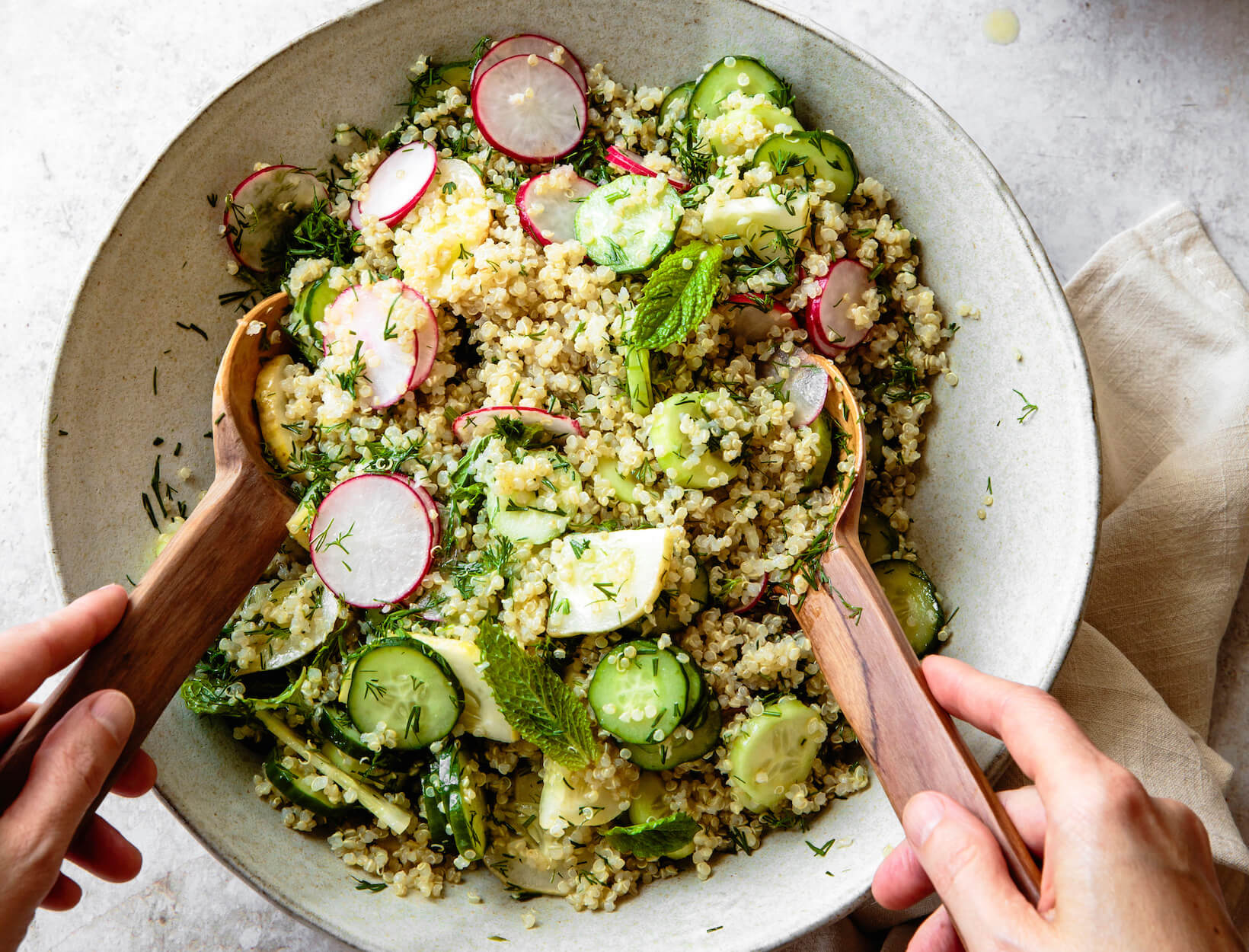Can You Eat Healthier and Heal Your
Relationship with Food?
Certified nutrition specialist Mia Rigden, MS, draws a distinction between food restriction and avoiding a specific food because it’s a mismatch for your physical or mental health. If your body screams lactose intolerance, for example, it doesn’t have to feel restrictive to skip the cheese plate at a party or seek out dairy-free versions of your favorite (creamy, cheesy, delightfully gooey) things. It’s just one way to take care of yourself.
-
That’s what’s behind Rigden’s idea of seeking out your “productive foods,” which she defines as ones that maximize pleasure and well-being at once. Finding them—they’re unique to each person and influenced by your body, upbringing, ethics, and lifestyle—is a goal she sets for her clients. A productive-foods mindset asks: What feels good, really?
If you haven’t dipped a toe into food journaling—a pathway to finding your productive foods, if you wish—Rigden’s The Well Journal is a wonderful way to get going. And Rigden is about to launch an online course on finding food freedom, available for preorder now.
-
Mia Rigden
The Well Journal
goop, $28SHOP NOW
Find Your Productive Foods
By Mia Rigden, MS, CNS

We can use science to formulate the “perfect” diet for our overall health, but if we don’t take lifestyle into account, it can be hard to execute. This is classic diet culture: encouraging people to follow a specific way of eating that doesn’t fit into their life. If you’ve ever said, “I know what to do, I’m just not doing it,” then you probably haven’t found your productive foods.
A productive food is one that looks good, tastes good, smells good, and makes you feel good. With a productive-foods mindset, we’re seeking foods that are just as exciting to the senses as they are to our health. Because we each have our own preferences and nutritional needs, which exact foods we consider productive will be different for everyone. Finding yours is the key to tapping into that sweet spot where your food choices naturally and effortlessly align with your body’s needs.
Many of my new clients laugh (or sigh out of relief) when I tell them my two firm rules: You have to like the food you’re eating, and it has to be easy. We’ve been taught that if we’re going to eat healthy foods and focus on nutrition it’s going to be an arduous, somewhat miserable task. That simply isn’t true.
“Many of my new clients laugh (or sigh out of relief) when I tell them my two firm rules: You have to like the food you’re eating, and it has to be easy.”
I’m also not suggesting that nutrition science doesn’t matter or that there isn’t work involved. Finding your productive foods can take time and requires dedication. Understanding your body, preferences, and cravings can involve soul searching, nutrition education, and trial and error. You may need to unlearn dogma that makes you feel at odds with the foods you love. Or you may need to commit to changing some of your eating patterns—for example, reducing your intake of sugar, alcohol, or overly processed foods, which can be habit-forming and can cloud your preferences.
The first step is identifying foods that might not be productive for you, and the second is to find a solution for each. If you love ice cream, for example, but have discovered that dairy causes you digestive discomfort and sugar makes you anxious, how much did you really enjoy the experience of eating ice cream? Perhaps finding a dairy-free flavor with less sugar (yes, they exist) feels like a compromise, but it might allow you to enjoy ice cream more freely because it doesn’t come with unpleasant side effects.
4 Steps to Discovering Your Productive Foods
1. Establish your motivation. Find at least one motivation for healthy eating that you can feel relatively immediately, like increased energy, digestive comfort, or improved mood. Weight change, while a perfectly acceptable goal for some, is an unreliable motivator. If this is a motivator for you, find another reason to encourage you to improve your nutrition.
2. Uncover any potential food reactions so you can make informed decisions about the best foods for your body. Keeping a food and lifestyle diary can help you connect the dots between how a food feels in the moment you’re eating it and how it makes you feel after. Try to stay away from apps that count calories or macros—it’s easy to get fixated on numbers, and productive foods are about more than that.
If you want to take it a step further, an elimination diet is the gold standard for discovering food reactions. An elimination diet removes one or more foods from your diet for a limited period of time, then reintroduces the food to allow you to monitor any changes in symptoms. I like to start with foods and substances that are often the least productive: gluten, dairy, sugar, alcohol, or caffeine. You can eliminate these all at once (check out my Reset program if you want some structure and recipes for an elimination protocol), or one at a time for a period of two to four weeks each. Symptoms of a food reaction can include fatigue, anxiety, brain fog, bloating, heartburn, constipation, acne, eczema or other skin reactions, and more. People often don’t even recognize they were experiencing these symptoms until they remove their triggers and start to feel more vibrant and energized. And when you raise your expectations for how you want to feel every day, you tend to prioritize trying to feel that way.
3. Think about nutrition as more than what you eat. There are many factors beyond food that influence your food choices and how you metabolize what you eat. Chronic stress, anxiety, and depression are proven to cause increased cravings for sugar, refined carbohydrates, and salty snack foods that were created to be eaten in excess. For example, lack of sleep increases stress levels, and when we’re stressed and tired, our bodies crave energy-rich foods like sugar. At the same time—and for the same reasons—we tend to lack the motivation to plan nutrient-dense meals. The foods we gravitate toward in these situations perpetuate a cycle of stress, anxiety, depression, and fatigue. But the hamster wheel does spin the other way: Movement and time in nature, for example, can improve your mood, energy levels, and sleep, while increasing your motivation and ability to make choices that are more supportive of your health.
4. Start with one productive meal and add on from there. You don’t have to have all the answers all at once. In fact, you’ll get better results if you focus on one meal at a time. I like to think of specific meal periods one by one until I have a list of productive food options. It helps to write it down—perhaps in your phone notes or on a notepad in the kitchen. Once you discover one meal, it gets easier to find others. Soon you’ll find that most of the foods you eat fall into the productive list. And as for the rest—well, life happens, and when your baseline feeling is groovy, you’ll tend to find your way back there.
No matter what your health and wellness goals are, the true transformation is in the process, and results come from consistency. By finding your productive foods, you will not only enjoy the process of reaching your goals much more, but it will be easier for to continue eating these foods. This is not about sacrifice or restriction. It’s a way to care for yourself and love what you eat that much more.
Mia Rigden, MS, CNS, is a board-certified nutritionist, health coach, and the founder of a private nutrition practice based in Los Angeles. She works with clients worldwide via one-on-one coaching, Mom Group (a group nutrition program for mothers), and The Reset, a twenty-one-day whole foods program. Rigden is also the author of The Well Journal and will be releasing a cookbook in 2022.
This article is for informational purposes only, even if and regardless of whether it features the advice of physicians and medical practitioners. This article is not, nor is it intended to be, a substitute for professional medical advice, diagnosis, or treatment and should never be relied upon for specific medical advice. The views expressed in this article are the views of the expert and do not necessarily represent the views of goop.



